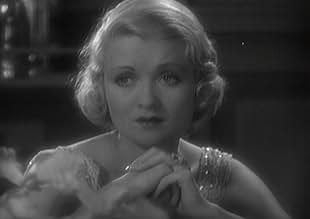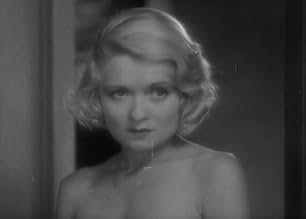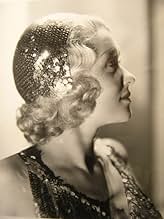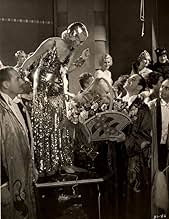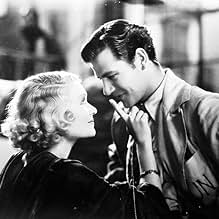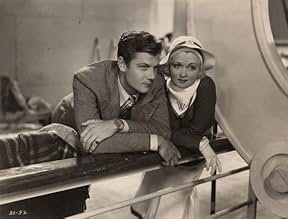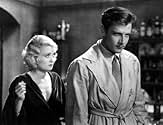Young Valerie models for an American painter who tries to make a future in Paris and they fall in love.Young Valerie models for an American painter who tries to make a future in Paris and they fall in love.Young Valerie models for an American painter who tries to make a future in Paris and they fall in love.
- Director
- Writers
- Stars
Emile Chautard
- Doorman
- (uncredited)
Albert Conti
- Strangeways Party Guest
- (uncredited)
Carrie Daumery
- Strangeways Party Guest
- (uncredited)
George Davis
- Charles - Dick's Butler
- (uncredited)
Julia Swayne Gordon
- Mrs. Strangeways
- (uncredited)
George Irving
- Doctor
- (uncredited)
Dolores Murray
- Queen at the Ball
- (uncredited)
Tom Ricketts
- Elderly Strangeways Party Guest
- (uncredited)
Marshall Ruth
- Strangeways Party Guest
- (uncredited)
- Director
- Writers
- All cast & crew
- Production, box office & more at IMDbPro
Featured reviews
Joel McCrea was one of the great stars of Twentieth Century movies. I'm not thinking of the Westerns for which he was best known, eventually, but for his light comedy, slapstick, and serious comedy. Not to mention his starring role in one of Hitchcock's very best: "Foreign Correspondent." It seems as if many of the fine directors wanted to work with him. In addition to Hitchcock, Preston Sturges used him -- twice. In "Sullivan's Travels" he is certainly an alter-ego for the writer/director.
Early in his career he did light fare, often paired, as here, with Constance Bennett. He also worked with Miriam Hopkins on several occasions, including the far from comic "These Three." Here he is a painter in Paris. He's from a rich family but he's rebelling. He uses Bennett as a model -- and we see her nude. Not totally but first in her undergarments and then with a towel covering the parts we aren't allowed to see.
So how come he is such a prig when he finds out she is a lady with a past? He sure is, though.
The movie is filled with thudding quips and boring banter. It is fun overall but it definitely could have been a great deal better.
Early in his career he did light fare, often paired, as here, with Constance Bennett. He also worked with Miriam Hopkins on several occasions, including the far from comic "These Three." Here he is a painter in Paris. He's from a rich family but he's rebelling. He uses Bennett as a model -- and we see her nude. Not totally but first in her undergarments and then with a towel covering the parts we aren't allowed to see.
So how come he is such a prig when he finds out she is a lady with a past? He sure is, though.
The movie is filled with thudding quips and boring banter. It is fun overall but it definitely could have been a great deal better.
A professionally made and superbly acted reflection of what respectability was considered to be at time when the old world gave way to our modern one. It's the familiar 'can love survive across the class divide' story but done with class.
My only criticism is that Paul Stein's direction is quite humourless and unemotional so it doesn't engage with you that easily. It's much more realistic than typical 1931 pictures but that lack of melodrama doesn't quite give this as much impact as some of its contemporaries. It is however a great time capsule reflecting the sexual and class based hypocrisies that prevailed at the time.
Another silly frustration for any red blooded male is Stein's habit of banishing his camera to the furthest darkest distance possible from Miss Bennett when she takes her clothes off, it's actually a lot more prudish than you might expect from a film about a nude model in 1931! Although she's not especially alluring or erotic, Constance Bennett is pretty fabulous in this. You can see why she commanded such a massive salary - her acting is outstanding, she's totally convincing, you're not watching an actress, you're watching Valerie, a real person, a fairly modern person whom you can really relate to and sympathise with today.
A real benefit in this is Robert Williams who injects just the right amount of good humour as McCrea's friend. Such a tragedy that he died before his career really took off - he would easily have been as good in those best friend roles Frank McHugh or Charles Ruggles monopolised and very likely, a leading man; such a shame. His cheerful nature adds a necessary lightness to this picture because as good as it is, it is a little cold and dry.
My only criticism is that Paul Stein's direction is quite humourless and unemotional so it doesn't engage with you that easily. It's much more realistic than typical 1931 pictures but that lack of melodrama doesn't quite give this as much impact as some of its contemporaries. It is however a great time capsule reflecting the sexual and class based hypocrisies that prevailed at the time.
Another silly frustration for any red blooded male is Stein's habit of banishing his camera to the furthest darkest distance possible from Miss Bennett when she takes her clothes off, it's actually a lot more prudish than you might expect from a film about a nude model in 1931! Although she's not especially alluring or erotic, Constance Bennett is pretty fabulous in this. You can see why she commanded such a massive salary - her acting is outstanding, she's totally convincing, you're not watching an actress, you're watching Valerie, a real person, a fairly modern person whom you can really relate to and sympathise with today.
A real benefit in this is Robert Williams who injects just the right amount of good humour as McCrea's friend. Such a tragedy that he died before his career really took off - he would easily have been as good in those best friend roles Frank McHugh or Charles Ruggles monopolised and very likely, a leading man; such a shame. His cheerful nature adds a necessary lightness to this picture because as good as it is, it is a little cold and dry.
In Paul L. Stein's 1931 film "The Common Law", Constance Bennett plays Valerie West, a "kept woman" who decides that she needs to leave her sugar-daddy boyfriend Nick and make a go of it on her own. She ends up working as an artist's model for painter John Neville, Jr. (McCrea), and while they begin their relationship as friends, the two soon become lovers. Unfortunately, there are a number of factors against them, namely Valerie's past as a kept woman and John's sister Claire (Hopper), who believes that Valerie is less than acceptable for their blue blood family. During his bouts of indecision, he succumbs to fits of jealousy about Valerie's past and finds it hard to trust her to be true to him, especially when she suggests they wait until they are absolutely sure of their love before they get married. Valerie, on the other hand, knows that she loves John but is afraid she will get hurt, particularly when she sees the rich life of which John's family are members.
There are a few notable things about "The Common Law", despite its relatively simple plot and short running time. Being a Pre-Code film, the role of Valerie is juicy without being compromised and saddled with social morays. It is clear that Valerie lived with both Nick and John and was married to neither of them, something that just was not expressed in post 1934 films. (The irony of this censorship doesn't escape me either; one would think that there would be a progression as the medium grows and not a recession.) This is where the title "The Common Law" is derived, and it is only near the end of the film when Valerie begins to feel personal and social pressure that she acquiesces to marry. It is left to the audience to interpret whether she is entirely comfortable with the situation, but she does not hide her apparent joy over her ultimate decision; it almost seems like a weight has been lifted off her shoulders.
Also notable are various obvious innuendos (like when Valerie is leaving Nick and he suggests, not cruelly, that she could perhaps survive well as a call girl) and the first scene in which Valerie poses nude for John, not five minutes after he hires her as a model. She is clearly uncomfortable, but loses her inhibitions quickly and though her form is not clear, the scene ends with a long shot showing her lying naked on the platform. This would have been unheard of in a post-code era where even the amorous Nick and Nora Charles were relegated to twin beds.
Constance Bennett, one of the most popular screen sirens of the pre-code Hollywood era, plays Valerie as tough, savvy and intelligent, but with one look she is able to express vulnerability and sadness. Her incredible beauty and impeccable style (her clothes not only look like they were made specifically for her, but are timeless as well) are literally breathtaking. There is no doubt that she is a star of enormous quality and talent. Particularly during this early period of "talkies", there were a plethora of actors and actresses who may have looked gorgeous but couldn't act their way out of a paper bag. It was those who could that became immortalized and revered, and Bennett more than deserves a place in this upper echelon. Unfortunately, this praise can't extend to the rest of the featured cast. Joel McCrea obviously hadn't hit his stride yet, though he had made over a dozen pictures before this one. Though he plays his usual role, the handsome, earnest and ruffled hero, it would be a few more years before he shows some of the greatness that he exhibited in films like "These Three" or a decade later in "Sullivan's Travels". While he is likable in this film (other than when he is being a jealous ass) it is obvious that there are times when he is waiting for his cues, and the delivery is wooden. I have never seen Hedda Hopper in a film other than when she had a cameo in "Sunset Boulevard", so I was first surprised when I saw her name in the credits and even more surprised when I did more research and saw that she actually did 82 other films BEFORE this one was released. And here I thought she was simply a gossip columnist though if her work in "The Common Law" is indicative of the rest of her repertoire, then she found her true calling about 130 films too late. Unfortunately, her nosiness and rumored bitchiness in real life could not be channeled into her role as McCrea's bitchy and nosy sister because she was just terrible.
"The Common Law" is a fine example of Hollywood's pre-code era, when women didn't have to be saints, or if they were "subversive" (by Hays Code standards) they would be punished in the end. Instead we have a strong female role in which her strength is complimented by moments of vulnerability, and despite a non-adherence to a strict moral code dictated by some sects of society, there is a happy ending after all. 6/10 --Shelly
There are a few notable things about "The Common Law", despite its relatively simple plot and short running time. Being a Pre-Code film, the role of Valerie is juicy without being compromised and saddled with social morays. It is clear that Valerie lived with both Nick and John and was married to neither of them, something that just was not expressed in post 1934 films. (The irony of this censorship doesn't escape me either; one would think that there would be a progression as the medium grows and not a recession.) This is where the title "The Common Law" is derived, and it is only near the end of the film when Valerie begins to feel personal and social pressure that she acquiesces to marry. It is left to the audience to interpret whether she is entirely comfortable with the situation, but she does not hide her apparent joy over her ultimate decision; it almost seems like a weight has been lifted off her shoulders.
Also notable are various obvious innuendos (like when Valerie is leaving Nick and he suggests, not cruelly, that she could perhaps survive well as a call girl) and the first scene in which Valerie poses nude for John, not five minutes after he hires her as a model. She is clearly uncomfortable, but loses her inhibitions quickly and though her form is not clear, the scene ends with a long shot showing her lying naked on the platform. This would have been unheard of in a post-code era where even the amorous Nick and Nora Charles were relegated to twin beds.
Constance Bennett, one of the most popular screen sirens of the pre-code Hollywood era, plays Valerie as tough, savvy and intelligent, but with one look she is able to express vulnerability and sadness. Her incredible beauty and impeccable style (her clothes not only look like they were made specifically for her, but are timeless as well) are literally breathtaking. There is no doubt that she is a star of enormous quality and talent. Particularly during this early period of "talkies", there were a plethora of actors and actresses who may have looked gorgeous but couldn't act their way out of a paper bag. It was those who could that became immortalized and revered, and Bennett more than deserves a place in this upper echelon. Unfortunately, this praise can't extend to the rest of the featured cast. Joel McCrea obviously hadn't hit his stride yet, though he had made over a dozen pictures before this one. Though he plays his usual role, the handsome, earnest and ruffled hero, it would be a few more years before he shows some of the greatness that he exhibited in films like "These Three" or a decade later in "Sullivan's Travels". While he is likable in this film (other than when he is being a jealous ass) it is obvious that there are times when he is waiting for his cues, and the delivery is wooden. I have never seen Hedda Hopper in a film other than when she had a cameo in "Sunset Boulevard", so I was first surprised when I saw her name in the credits and even more surprised when I did more research and saw that she actually did 82 other films BEFORE this one was released. And here I thought she was simply a gossip columnist though if her work in "The Common Law" is indicative of the rest of her repertoire, then she found her true calling about 130 films too late. Unfortunately, her nosiness and rumored bitchiness in real life could not be channeled into her role as McCrea's bitchy and nosy sister because she was just terrible.
"The Common Law" is a fine example of Hollywood's pre-code era, when women didn't have to be saints, or if they were "subversive" (by Hays Code standards) they would be punished in the end. Instead we have a strong female role in which her strength is complimented by moments of vulnerability, and despite a non-adherence to a strict moral code dictated by some sects of society, there is a happy ending after all. 6/10 --Shelly
It was said, possibly by David Niven, that Constance Bennett would walk into a room at night to play cards and emerge the next morning looking exactly the same as when she went in. I can believe it. Her beauty, glamor, and freshness are beautifully showcased in "The Common Law" about living and loving (freely) in Paris.
It seems strange that a movie made in 1931 should seem more modern than later films, but we can thank the Hayes code for that. In The Common Law, Bennett, when she's not shacking up with some guy, is a model for an artist, played by boyish Joel McCrea. The two fall in love, go through a breakup and reconcile. She is reticent about getting married. Then McCrea's conniving sister, having heard all the rumors, lures both she and McCrea back to America.
McCrea and Bennett made several films together, and they are a beautiful couple. He's big and wholesome; she's delicate and sophisticated. And of course, they're both incredibly beautiful.
It's always interesting to catch a pre-code movie, and The Common Law is a good one.
It seems strange that a movie made in 1931 should seem more modern than later films, but we can thank the Hayes code for that. In The Common Law, Bennett, when she's not shacking up with some guy, is a model for an artist, played by boyish Joel McCrea. The two fall in love, go through a breakup and reconcile. She is reticent about getting married. Then McCrea's conniving sister, having heard all the rumors, lures both she and McCrea back to America.
McCrea and Bennett made several films together, and they are a beautiful couple. He's big and wholesome; she's delicate and sophisticated. And of course, they're both incredibly beautiful.
It's always interesting to catch a pre-code movie, and The Common Law is a good one.
Joel McCrea plays an American artist living in Paris. He hires a woman (Constance Bennett) to be his nude model and eventually they fall in love. However, when he learns she has a tawdry past, he runs off to brood. Later, at debaucherous party, they meet once again. Soon, he asks her to marry him--she suggests they cohabitate to see if he really wants her. When the scandal of this relationship reaches his rich parents' ears, his mother schemes to pull the two lovers apart. However, in a strange scene, McCrea's on-screen father says that he heartily approves of the pair living together and wishes them the best! What happens next? See this odd film for yourself to find out for yourself.
If you haven't guessed, this film is CLEARLY an example of Pre-Code sensibilities. What I mean by that is that up until mid-1934, Hollywood's sense of morality was FAR looser than most folks would believe today. This was especially true from 1930-34--where adultery, premarital sex, violence, foul language, abortion and partial nudity were not terribly uncommon on the screen. But this moral code was not in line with America and soon folks started avoiding movies and ticket sales dropped. Soon, to lure back families, a strengthened Production Code was enforced--and films became, at times, a bit over-sanitized--but very family-friendly. Because of all this, there is zero chance this film could have been made after the Code was enforced--at least not without LOTS of revisions as well as a clear message that such immorality MUST be punished. But here in "The Common Law", the villains are NOT people who flaunt morality but the narrow-minded folks who don't approve and who, in some cases, are simply hypocrites! So is it worth seeing? Well, the film is well-acted and interesting. And, I do enjoy seeing many of the Pre-Code films because they are so strange and confusing--and entertaining!! So, I'd say this is very much worth seeing and a fine example of the genre.
If this isn't a plot that screams 'I'm a Pre-Code film!', nothing is!!
If you haven't guessed, this film is CLEARLY an example of Pre-Code sensibilities. What I mean by that is that up until mid-1934, Hollywood's sense of morality was FAR looser than most folks would believe today. This was especially true from 1930-34--where adultery, premarital sex, violence, foul language, abortion and partial nudity were not terribly uncommon on the screen. But this moral code was not in line with America and soon folks started avoiding movies and ticket sales dropped. Soon, to lure back families, a strengthened Production Code was enforced--and films became, at times, a bit over-sanitized--but very family-friendly. Because of all this, there is zero chance this film could have been made after the Code was enforced--at least not without LOTS of revisions as well as a clear message that such immorality MUST be punished. But here in "The Common Law", the villains are NOT people who flaunt morality but the narrow-minded folks who don't approve and who, in some cases, are simply hypocrites! So is it worth seeing? Well, the film is well-acted and interesting. And, I do enjoy seeing many of the Pre-Code films because they are so strange and confusing--and entertaining!! So, I'd say this is very much worth seeing and a fine example of the genre.
If this isn't a plot that screams 'I'm a Pre-Code film!', nothing is!!
Did you know
- TriviaThe screenplay was written by John Farrow. Five years later he married actress Maureen O'Sullivan, with whom he had seven children including actress Mia Farrow.
- Quotes
John Neville Sr.: You're getting more like your mother every day.
Mrs. Claire Collis: I should think that would make you very happy.
John Neville Sr.: It does. And a little apprehensive.
- ConnectionsFeatured in Thou Shalt Not: Sex, Sin and Censorship in Pre-Code Hollywood (2008)
Details
- Release date
- Country of origin
- Languages
- Also known as
- Diosas de Montmartre
- Filming locations
- Paris, France(second unit, background and establishing shots)
- Production company
- See more company credits at IMDbPro
Box office
- Budget
- $339,000 (estimated)
- Runtime
- 1h 14m(74 min)
- Color
Contribute to this page
Suggest an edit or add missing content

